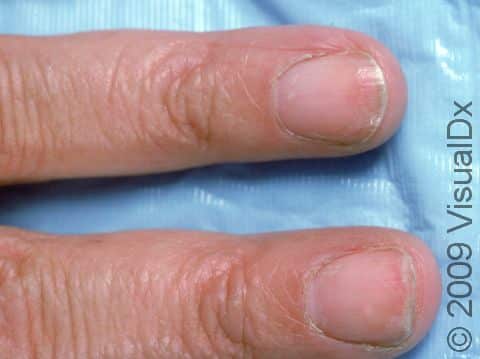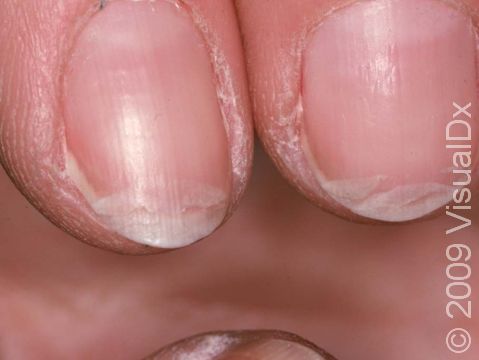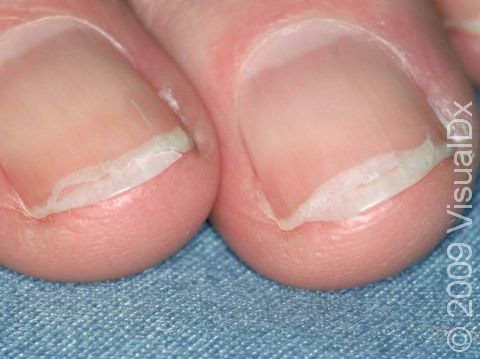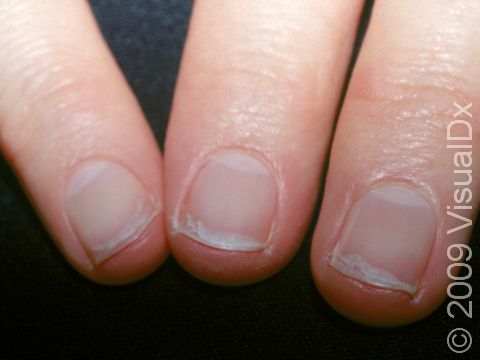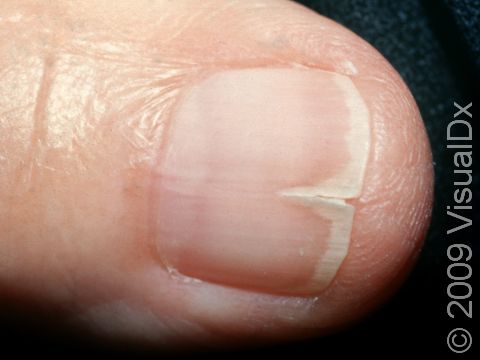Nail Splitting (Onychoschizia)
Onychoschizia, commonly known as nail peeling or nail splitting, is a condition that causes horizontal splits (across the width of the nail) in the nail plate. Onychoschizia may be seen along with another common nail condition called onychorrhexis, which involves longitudinal (across the length of the nail) splits or ridges in the nail plate. These conditions alone or together are sometimes simply called “brittle nails.”
Frequent wetting and drying of the hands is the most common cause of brittle nails. Brittle nails may also be caused by nail cosmetics (hardeners, polish, polish removers / solvents), nail procedures, and occupational exposure to various chemicals (alkalis, acids, cement, solvents, thioglycolates, salt, sugar solutions). Nail injury may also cause the development of brittle nails.
Brittle nails may also occur due to underlying medical problems such as gland (endocrine system) diseases, tuberculosis, Sjögren syndrome, and malnutrition. People with other skin diseases, such as lichen planus and psoriasis, as well as people taking oral medications made from vitamin A (retinoids), may also develop brittle nails.
Who's At Risk?
Brittle nails are fairly common, affecting nearly 20% of the population. They are most frequent in women and older adults.
People in occupations requiring frequent wetting and drying of the hands or who work with chemicals are also at increased risk for brittle nails.
Horizontal splitting of the thumbnails and big toes is quite common in newborns, affecting about 1 in 3 newborns. Fingernail and toenail splitting in children up to age 2 years is also seen, and it is thought to be because their nails are so thin. Thumb sucking can also be a contributing factor in nail splitting.
Signs & Symptoms
- The fingernails and toenails can be affected. There may be a single horizontal split between layers of the nail plate at the growing end or multiple splits and loosening of the growing edge of the nail plate (where the end of the finger or toe is attached to the nail itself).
- There may be horizontal nail splitting along with longitudinal ridging or splitting.
- Splitting or ridging of the nails may be seen in people with certain conditions such as psoriasis or lichen planus or in people who take oral medications made from vitamin A (oral retinoids).
Self-Care Guidelines
To help improve brittle nails and nail splitting and peeling:
- Reduce how often you wet and dry your nails.
- Wear plastic or rubber gloves over thin cotton gloves while doing all housework, including food preparation.
- Keep the nails trimmed short.
- Apply thick moisturizers (eg, CeraVe Moisturizing Cream) or petroleum jelly (eg, Vaseline) to improve nail hydration.
- Nail-hardening agents containing formaldehyde may increase nail strength, but they should be used cautiously, as they can cause brittleness and other nail problems. Apply these hardeners only to the free edge (growing end) of the nail.
- Acrylate-containing hardeners are also effective, but they may cause an allergic reaction in the skin.
Treatments
Your medical professional will first want to determine the cause of your brittle, peeling, or splitting nails, such as an underlying medical condition or nail disease. If there is a medication causing your nail issues, your medical professional can help determine if another medication may be an appropriate substitute.
Visit Urgency
Brittle, peeling, or splitting nails may be merely a cosmetic problem, but see your medical professional if it becomes bothersome or there may be an underlying cause such as a medical condition or a medication.
Trusted Links
References
Bolognia J, Schaffer JV, Cerroni L. Dermatology. 4th ed. Philadelphia, PA: Elsevier; 2018.
James WD, Elston D, Treat JR, Rosenbach MA. Andrew’s Diseases of the Skin. 13th ed. Philadelphia, PA: Elsevier; 2019.
Kang S, Amagai M, Bruckner AL, et al. Fitzpatrick’s Dermatology. 9th ed. New York, NY: McGraw-Hill Education; 2019.
Last modified on June 18th, 2024 at 12:50 pm

Not sure what to look for?
Try our new Rash and Skin Condition Finder
